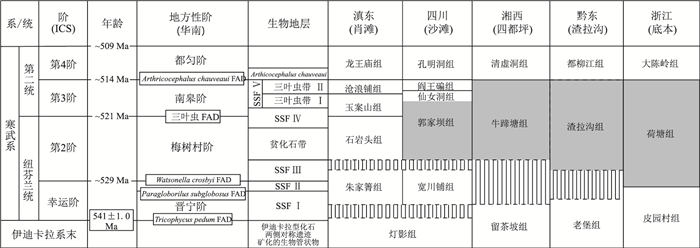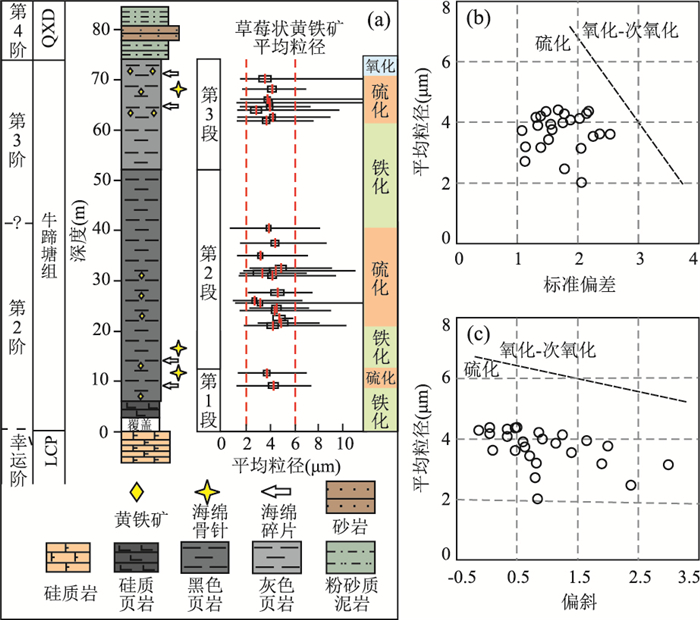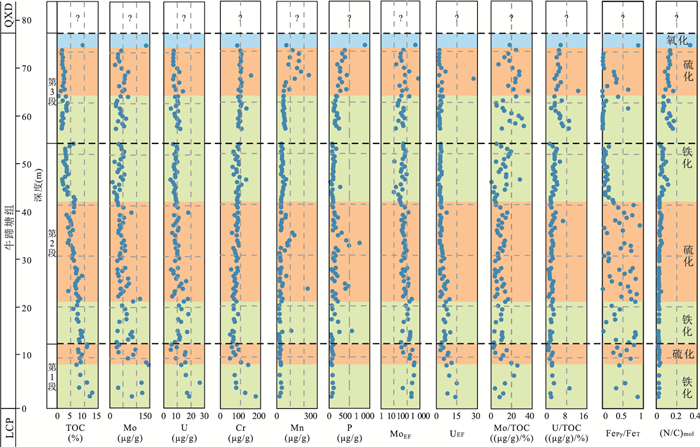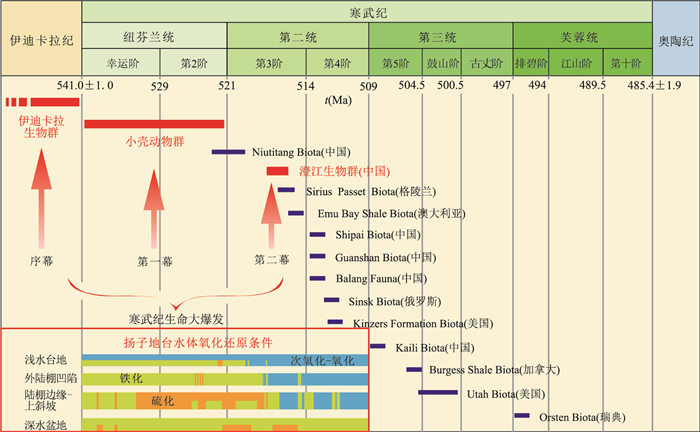Stepwise Oxygenation of Early Cambrian Ocean Drove Early Metazoan Diversification
-
摘要: 伊迪卡拉-寒武纪过渡期是地球历史上海洋环境与生命演化变革的关键时期之一.有研究认为海洋氧化可能是驱动早寒武世动物快速多样化的主要原因,但有关海洋氧化及硫化水体演变过程和发生时间的认识仍有分歧.运用ICP-MS、FESEM、EDS和XRD技术对位于古陆架边缘-斜坡背景的湘西四都坪、黔东松江大桥等剖面牛蹄塘组黑色页岩进行氧化还原敏感元素、黄铁矿形态学、总有机碳及N、P等营养元素丰度变化进行高分辨研究.结果显示,研究区牛蹄塘沉积期底层海水条件经历了复杂的发展过程,表现为3个铁化与3个硫化时段的动态交互,在第3阶晚期转为亚氧化-氧化条件.不同相区的对比表明,海水氧化随时间由浅水向深水区扩展:台地相区发生在第2阶晚期,陆架边缘出现在第3阶晚期,而深水盆地以持续铁化为主,晚期出现硫化,表明海洋氧化界面逐步加深下移.沉积物Mo/TOC,U/TOC值自下而上持续增加,与Cr、Mn、P、N丰度变化趋势一致,表明海水氧化程度逐步增强.主要化石类群的时空分布与海水氧化过程对应良好,表明海洋阶段性氧化与硫化水体消失对后生动物多样化进程有明显的控制作用.Abstract: Ediacaran-Cambrian transition is a critical period in Earth history, during which both marine environment and life have experienced drastic changes. It is arguably suggested that pervasive oxygenation and associated geochemical changes in the ocean have potentially driven the rapid diversification of Early Cambrian metazoans, however, the timing and process of ocean oxygenation have not been well constrained. In this paper, an integrated study was conducted on the Lower Cambrian Niutitang (NTT) Fm. in Siduping area, West Hunan and Songjiang Bridge area, East Guizhou, which were paleogeographically situated at the shelf margin-upper slope setting of the Yangtze block. Using ICP-MS, FESEM, EDS and XRD techniques, the abundances and patterns of RSE (redox sensitive elements), pyrite morphology, TOC (total organic carbon), as well as N, P nutrients were investigated systematically. The results show that during NTT deposition, bottom seawaters in the study area experienced a complicated evolution, with a dynamic alternation of 3 ferruginous and 3 euxinic intervals, and suboxic-oxic conditions occurring only at the latest Cambrian Stage 3. Comparison with relevant data published previously from each facies belts within the Yangtze block shows that the seawater oxygenation was a progressive process expanding from shallow water area to deep-water area in time. Platform facies area oxygenated at the late Stage 2, shelf margin area in the late Stage 3, and the deep-water basin kept ferruginous until the latest Stage 3, when it became euxinic. Sediment Mo/TOC, U/TOC ratios increased from bottom to top consecutively in the section, coupled with elevated Cr, Mn, N and P secular trends, likely indicating an overall enhancement of seawater oxygenation. The spatial-temporal distribution and increased paleoecologic complexity of major fossil groups in the Yangtze block over time show a well coincidence with the seawater oxygenation process, likely implying that increased ocean oxygenation and declined euxinic seawaters have facilitated the rapid diversification of Early Cambrian metazoans.
-
图 1 扬子地区晚伊迪卡拉纪-早寒武世沉积古地理背景及研究区地层序列
a.沉积古地理简图,据Jiang et al.(2007)、Steiner et al.(2007)、Xu et al.(2012)、Och et al.(2013)等修改补充;b.NW-SE向古地势示意图;c.研究区晚伊迪卡拉-早寒武世地层序列.图a中红色五星表示前人研究的剖面,蓝色三角表示本文研究的剖面
Fig. 1. Simplified paleogeography of South China during Ediacaran-Cambrian transition and typical stratigraphic succession in the study area
图 2 扬子地台不同相区晚伊迪卡拉纪至寒武纪早期地层划分与对比
据Steiner et al.(2007)、Zhao et al.(2012)、Jin et al.(2016)和Xiang et al.(2017)等资料综合修改.SSF.小壳类化石组合(small shelly fossils);FAD.化石首现点(first appearance datum);灰色方块表示黑色页岩为主的地层单位;竖线条表示地层缺失
Fig. 2. Stratigraphic subdivisions and correlation of the Late Ediacaran-Early Cambrian transition on the Yangtze platform
图 3 研究区下寒武统牛蹄塘组(NTT)沉积类型与微相特征
a.松桃松江大桥牛蹄塘组下部黑色页岩与留茶坡组分界;b.江口平引村牛蹄塘组底部黑色泥岩中的磷结核;c.湘西四都坪牛蹄塘组下部硅化-硅质页岩;d.松江大桥牛蹄塘组一段下部黑色页岩;e.松江大桥牛蹄塘组下部黑色泥页岩中的黄铁矿条带;f.四都坪牛蹄塘组下部硅质页岩中的硅化球粒和石英粉砂;g.四都坪牛蹄塘组一段上部黄铁矿条带;h.四都坪牛蹄塘组一段自形黄铁矿;i.四都坪牛蹄塘组二段上部草莓状黄铁矿;j.四都坪牛蹄塘组二段上部草莓状黄铁矿.a~e.野外照片;f~i.显微照片;j.SEM照片.照片中,Euhd.自形黄铁矿;Fr.草莓状黄铁矿;Qz.硅化微球粒
Fig. 3. Sedimentary types and micro-facies features of the Niutitang (NTT) Fm. in study area
图 7 寒武纪大爆发过程中主要后生动物类群出现与海水氧化的时间对比
生物资料据Shu(2008)、朱茂炎(2010)、Erwin(2011)和Shu et al.(2014)等资料综合;海水条件变化据本文研究
Fig. 7. Time correlation of major metazoan group occurrence with ocean oxygenation during the Cambrian explosion
表 1 四都坪牛蹄塘组(NTT)黑色页岩主量元素分析数据
Table 1. Major element data of the black shale from the NTT Fm., Siduping, West Hunan
单元平均值 SiO2
(%)TiO2
(%)Al2O3
(%)Fe2O3T
(%)MgO
(%)CaO
(%)Na2O
(%)K2O
(%)MnO
(μg/g)P2O5
(μg/g)LOI
(%)总量
(%)第1段(0~13 m;n=14) 下部 73.7 0.4 9.7 0.5 0.9 0.2 0.7 2.9 30.8 165.3 10.4 99.5 上部 77.8 0.4 8.9 0.5 0.7 0.1 0.7 2.6 26.4 148.9 7.8 99.5 全段 76.0 0.4 9.3 0.5 0.8 0.2 0.7 2.7 28.3 155.9 8.9 99.5 第2段(13~55 m;n=69) 下部 75.8 0.4 9.8 1.1 0.9 0.4 1.0 2.4 32.4 318.3 7.5 99.5 中部 74.7 0.5 11.0 1.7 1.2 0.2 1.1 2.6 46.5 391.8 6.5 99.5 上部 72.7 0.6 13.3 1.2 1.3 0.2 1.1 3.4 51.3 288.3 5.8 99.6 全段 73.8 0.5 12.0 1.4 1.2 0.2 1.1 3.0 47.0 325.7 6.3 99.5 第3段(55~74 m;n=28) 下部 69.9 0.7 16.7 1.4 1.2 0.1 0.7 4.6 57.7 338.3 4.2 99.7 上部 71.5 0.6 13.0 2.8 0.2 0.1 0.9 3.3 126.9 625.9 5.4 98.0 顶部 73.1 0.3 6.7 2.8 0.0 0.1 0.7 1.6 76.2 1815.3 12.8 98.3 全段 70.8 0.7 14.5 2.1 0.7 0.1 0.8 3.9 93.0 534.9 5.1 98.8 牛蹄塘组 全组 73.3 0.6 12.3 1.5 1.0 0.2 1.0 3.2 56.2 357.0 6.3 99.4 注:由于测试样品较多,本表仅给出各层段的统计平均值,n表示该段测试样品数;以下各表同. 表 2 四都坪牛蹄塘组黑色页岩各层段微量及其他关注元素的分析结果
Table 2. Trace element data and concerned ratios for subdivided intervals of the NTT Fm., Siduping, West Hunan
单元平均值 TOC
(%)TN
(%)TS
(%)Mo
(μg/g)U
(μg/g)V
(μg/g)MoEF UEF VEF Mo/TOC
((μg/g)/%)U/TOC
((μg/g)/%)δEu P
(μg/g)Cr
(μg/g)Mn
(μg/g)Cu
(μg/g)Zn
(μg/g)(N/C)mol FePy/
FeTFe/
Al下部 7.9 0.2 0.3 105 25.1 1327.1 206.4 14.8 18.2 14.1 3.4 1.2 72.2 99.8 23.9 8.6 14.5 0.03 0.72 0.07 上部 7.2 0.2 0.3 57.6 10.5 322.4 126.8 6.1 4.1 8.4 1.5 1.4 65.0 65.1 20.4 7.3 11.7 0.03 0.71 0.07 全段 7.5 0.2 0.3 78.2 16.8 753.0 160.9 9.8 10.1 10.9 2.3 1.4 68.1 80.0 21.9 7.9 12.9 0.03 0.72 0.07 下部 6.4 0.2 0.3 54.7 12.7 186.2 105.0 6.9 1.6 8.6 2.0 1.0 139.0 59.7 25.1 18.1 11.8 0.02 0.41 0.15 中部 5.3 0.2 0.7 43.4 10.3 151.6 74.6 4.8 0.9 8.2 2.0 1.0 171.1 66.6 36.0 23.3 24.6 0.03 0.48 0.20 上部 3.4 0.2 0.4 31.8 8.8 217.1 44.9 3.1 1.2 10.4 2.8 1.1 125.9 75.5 39.7 8.5 17.6 0.06 0.27 0.13 全段 4.4 0.2 0.5 38.8 9.9 191.7 63.1 4.2 1.2 9.5 2.4 1.0 142.2 70.4 36.4 14.6 19.0 0.04 0.36 0.16 下部 1.9 0.2 0.1 30.5 9.6 325.6 33.9 2.5 1.8 22.0 6.9 1.1 147.7 89.4 44.7 6.1 17.4 0.14 0.07 0.11 上部 1.8 0.3 0.7 38.9 8.7 292.0 97.3 4.8 3.9 21.4 5.1 1.2 273.3 93.1 98.3 19.8 6.3 0.13 0.31 0.42 顶部 7.5 3.1 3.5 135 42.8 959.2 381.9 38.0 18.3 18.0 5.7 1.4 792.6 75.6 59.1 68.2 3.3 0.35 1.48 0.56 全段 2.0 0.4 0.5 38.5 10.3 331.4 78.0 4.9 3.4 21.6 6.0 1.1 233.5 90.8 72.0 15.2 11.3 0.14 0.24 0.28 全组 4.2 0.2 0.5 43.7 10.8 297.8 79.2 5.1 2.9 12.7 3.3 1.1 155.9 76.7 43.6 13.9 16.3 0.07 0.37 0.18 注:FePy据TS(总硫)含量的95%经化学式计算;(N/C)mol据TOC和TN(总氮)含量的摩尔值计算. 表 3 四都坪牛蹄塘组黑色页岩中草莓状黄铁矿形态统计分析数据
Table 3. Morphological statistics of pyrite from the NTT Fm., Siduping, West Hunan
样品 高度(m) 数量(个) Dave(μm) Dmax(μm) Dmin(μm) 标准偏差(μm) 偏斜 密度(个/mm2) 第1段 SDP-0700 9.0 82 4.28 7.35 1.22 1.77 -0.13 182 SDP-0950 11.5 77 3.73 6.98 1.21 1.07 0.63 171 第2段 SDP-1900 21.0 64 3.54 10.23 1.82 2.24 1.40 142 SDP-1950 21.5 30 3.61 8.03 2.97 2.53 0.47 67 SDP-2050 22.5 51 4.32 9.12 2.46 2.15 0.34 113 SDP-2200 24.0 182 4.36 8.97 1.49 1.47 0.47 404 SDP-2250 24.5 55 4.08 7.17 2.28 1.87 0.35 122 SDP-2350 25.5 178 3.17 12.00 1.09 1.38 1.90 396 SDP-2400 26.0 165 2.71 6.65 0.91 1.12 0.80 367 SDP-2560 27.6 37 3.62 7.45 2.14 2.35 0.10 82 SDP-2900 31.0 85 3.99 9.34 1.40 1.75 0.92 189 SDP-2950 31.5 21 2.01 6.96 1.48 2.05 0.84 47 SDP-3000 32.0 49 4.13 10.95 1.77 2.02 1.25 109 SDP-3050 32.5 59 4.37 9.04 2.30 2.17 0.05 131 SDP-3300 35.0 145 3.19 7.05 1.26 1.13 0.82 322 SDP-3550 37.5 124 4.41 8.60 1.51 1.67 0.50 276 SDP-4050 42.5 231 3.90 8.06 0.65 1.33 0.60 513 第3段 13SSTW-14 62.0 79 3.43 7.56 1.25 1.51 0.71 176 13SSTW-13 62.7 159 4.21 8.88 1.28 1.38 0.86 353 13SSTW-11 64.1 54 2.46 9.65 1.27 1.77 2.38 120 13SSTW-10 64.8 92 3.85 7.29 1.49 1.34 1.14 204 13SSTW-9 65.5 200 3.94 12.96 1.22 1.55 1.65 444 13SSTW-8 66.2 172 3.76 12.69 1.51 1.57 2.00 382 13SSTW-5 68.3 57 4.17 6.90 1.67 1.30 0.05 127 13SSTW-2 70.4 50 3.14 12.78 1.51 2.05 3.00 111 注:Dave.平均粒径;Dmin.最小粒径;Dmax.最大粒径;高度指该样品距剖面底部距离,数量指测量的黄铁矿莓球个数;密度指单位面积内黄铁矿莓球个数.在剖面0~8.5 m,12.0~20.5 m,43.0~61.5 m和70.7~74.0 m的4个地层间隔段内样品中未见草莓状黄铁矿,故未列出. 表 4 四都坪牛蹄塘组中硫化与非硫化时段微量元素数据比较
Table 4. Comparison of trace element data for recognized euxinic and non-euxinic intervals in the NTT Fm., Siduping, West Huanan
单元平均值 高度
(m)Mo
(μg/g)U
(μg/g)V
(μg/g)MoEF UEF VEF Mo/TOC
((μg/g)/%)U/TOC
((μg/g)/%)δEu P
(μg/g)Cr
(μg/g)Mn
(μg/g)(N/C)mol FePy/
FeT非硫化 非硫化A 2~8 105.7 25.1 1 327.1 206.4 14.8 18.2 14.1 3.4 1.2 72.2 99.8 23.9 0.03 0.72 非硫化B 12~21 46.9 11.6 180.7 90.9 6.2 1.5 7.2 1.8 1.0 122.5 59.6 24.0 0.02 0.46 非硫化C 43~61 31.4 8.9 285.3 40.7 2.7 1.7 16.7 4.8 1.1 116.3 82.3 39.3 0.10 0.11 硫化 硫化1 8~12 79.7 12.2 418.4 176.6 7.3 5.6 11.9 1.8 1.6 63.6 68.4 20.4 0.03 0.79 硫化2 21~43 38.0 9.8 164.8 60.5 4.1 0.9 8.2 2.2 1.0 164.3 70.0 39.6 0.04 0.44 硫化3 61~71 38.7 8.2 291.5 101.8 4.9 4.2 20.3 4.5 1.2 275.3 93.3 102.5 0.13 0.33 亚氧化-氧化 亚氧化-氧化 71~74 135.6 42.8 959.2 381.9 38.0 18.3 18.0 5.7 1.4 792.6 75.6 59.1 0.35 1.48 -
Algeo, T.J., Lyons, T.W., 2006.Mo-Total Organic Carbon Covariation in Modern Anoxic Marine Environments:Implications for Analysis of Paleoredox and Paleohydrographic Conditions.Paleoceanography, 21(1):1-23. https://doi.org/10.1029/2004pa001112 Algeo, T.J., Rowe, H., 2012.Paleoceanographic Applications of Trace-Metal Concentration Data.Chemical Geology, 324-325:6-18. https://doi.org/10.1016/j.chemgeo.2011.09.002 Cai, C., Xiang, L., Yuan, Y., et al., 2015.Marine C, S and N Biogeochemical Processes in the Redox-Stratified Early Cambrian Yangtze Ocean.Journal of the Geological Society, 172(3):390-406. https://doi.org/10.1144/jgs2014-054 Chen, D.Z., Zhou, X.Q., Fu, Y., et al., 2015a.New U-Pb Zircon Ages of the Ediacaran-Cambrian Boundary Strata in South China.Terra Nova, 27(1):62-68. https://doi.org/10.1111/ter.12134 Chen, X., Ling, H.F., Vance, D., et al., 2015b.Rise to Modern Levels of Ocean Oxygenation Coincided with the Cambrian Radiation of Animals.Nature Communications, 6(1):7142. https://doi.org/10.1038/ncomms8142 Cheng, M., Li, C., Zhou, L., et al., 2016.Marine Mo Biogeochemistry in the Context of Dynamically Euxinic Mid-Depth Waters:A Case Study of the Lower Cambrian Niutitang Shales, South China.Geochimica et Cosmochimica Acta, 183:79-93. https://doi.org/10.1016/j.gca.2016.03.035 Erwin, D.H., 2011.Evolutionary Uniformitarianism.Developmental Biology, 357:27-34. https://doi.org/10.1016/j.ydbio.2011.01.020 Feng, L.J., Li, C., Huang, J., et al., 2014.A Sulfate Control on Marine Mid-Depth Euxinia on the Early Cambrian (ca.529-521 Ma) Yangtze Platform, South China.Precambrian Research, 246:123-133. https://doi.org/10.1016/j.precamres.2014.03.002 Föllmi, K.B., 1996.The Phosphorus Cycle, Phosphogenesis and Marine Phosphate-Rich Deposits.Earth-Science Reviews, 40(1-2):55-124. https://doi.org/10.1016/0012-8252(95)00049-6 Frei, R., Gaucher, C., Døssing, L.N., et al., 2011.Chromium Isotopes in Carbonates-A Tracer for Climate Change and for Reconstructing the Redox State of Ancient Seawater.Earth and Planetary Science Letters, 312(1-2):114-125. https://doi.org/10.1016/j.epsl.2011.10.009 Frei, R., Gaucher, C., Poulton, S.W., et al., 2009.Fluctuations in Precambrian Atmospheric Oxygenation Recorded by Chromium Isotopes.Nature, 461(7261):250-253. https://doi.org/10.1038/nature08266 Fu, Y., Dong, L., Li, C., et al., 2016.New Re-Os Isotopic Constrains on the Formation of the Metalliferous Deposits of the Lower Cambrian Niutitang Formation.Journal of Earth Science, 27(2):271-281. https://doi.org/10.1007/s12583-016-0606-7 Gao, P., Liu, G.D., Jia, C.Z., et al., 2016.Redox Variations and Organic Matter Accumulation on the Yangtze Carbonate Platform during Late Ediacaran-Early Cambrian:Constraints from Petrology and Geochemistry.Palaeogeography, Palaeoclimatology, Palaeoecology, 450:91-110. https://doi.org/10.1016/j.palaeo.2016.02.058 Gilleaudeau, G.J., Frei, R., Kaufman, A.J., et al., 2016.Oxygenation of the Mid-Proterozoic Atmosphere:Clues from Chromium Isotopes in Carbonates.Geochemical Perspectives Letters, 178-187. https://doi.org/10.7185/geochemlet.1618 Gilleaudeau, G.J., Kah, L.C., 2013.Oceanic Molybdenum Drawdown by Epeiric Sea Expansion in the Mesoproterozoic.Chemical Geology, 356:21-37. https://doi.org/10.1016/j.chemgeo.2013.07.004 Glass, J.B., Wolfe-Simon, F., Anbar, A.D., 2009.Coevolution of Metal Availability and Nitrogen Assimilation in Cyanobacteria and Algae.Geobiology, 7(2):100-123. https://doi.org/10.1111/j.1472-4669.2009.00190.x Goldberg, T., Strauss, H., Guo, Q.J., et al., 2007.Reconstructing Marine Redox Conditions for the Early Cambrian Yangtze Platform:Evidence from Biogenic Sulphur and Organic Carbon Isotopes.Palaeogeography, Palaeoclimatology, Palaeoecology, 254(1-2):175-193. https://doi.org/10.1016/j.palaeo.2007.03.015 Guo, Q.J., Shields, G.A., Liu, C.Q., et al., 2007.Trace Element Chemostratigraphy of Two Ediacaran-Cambrian Successions in South China:Implications for Organosedimentary Metal Enrichment and Silicification in the Early Cambrian.Palaeogeography, Palaeoclimatology, Palaeoecology, 254(1-2):194-216. https://doi.org/10.1016/j.palaeo.2007.03.016 Jiang, G.Q., Wang, X.Q., Shi, X.Y., et al., 2012.The Origin of Decoupled Carbonate and Organic Carbon Isotope Signatures in the Early Cambrian (ca.542-520 Ma) Yangtze Platform.Earth and Planetary Science Letters, 317-318:96-110. https://doi.org/10.1016/j.epsl.2011.11.018 Jiang, S.Y., Yang, J.H., Ling, H.F., et al., 2007.Extreme Enrichment of Polymetallic Ni-Mo-PGE-Au in Lower Cambrian Black Shales of South China:An Os Isotope and PGE Geochemical Investigation.Palaeogeography, Palaeoclimatology, Palaeoecology, 254(1-2):217-228. https://doi.org/10.1016/j.palaeo.2007.03.024 Jin, C.S., Li, C., Algeo, T.J., et al., 2016.A Highly Redox-Heterogeneous Ocean in South China during the Early Cambrian (~529-514 Ma):Implications for Biota-Environment Co-Evolution.Earth and Planetary Science Letters, 441:38-51. https://doi.org/10.1016/j.epsl.2016.02.019 Johnson, J.E., Webb, S.M., Ma, C., et al., 2016.Manganese Mineralogy and Diagenesis in the Sedimentary Rock Record.Geochimica et Cosmochimica Acta, 173:210-231. https://doi.org/10.1016/j.gca.2015.10.027 Lan, Z.W., Li, X.H., Chu, X.L., et al., 2017.SIMS U-Pb Zircon Ages and Ni-Mo-PGE Geochemistry of the Lower Cambrian Niutitang Formation in South China:Constraints on Ni-Mo-PGE Mineralization and Stratigraphic Correlations.Journal of Asian Earth Sciences, 137:141-162. https://doi.org/10.1016/j.jseaes.2016.12.046 Landing, E., Geyer, G., Brasier, M.D., et al., 2013.Cambrian Evolutionary Radiation:Context, Correlation, and Chronostratigraphy-Overcoming Deficiencies of the First Appearance Datum (FAD) Concept.Earth-Science Reviews, 123:133-172. https://doi.org/10.1016/j.earscirev.2013.03.008 Li, C., Jin, C.S., Planavsky, N.J., et al., 2017.Coupled Oceanic Oxygenation and Metazoan Diversification during the Early-Middle Cambrian? Geology, 45(8):743-746. https://doi.org/10.1130/g39208.1 Li, Z.X., Bogdanova, S.V., Collins, A.S., et al., 2008.Assembly, Configuration, and Break-up History of Rodinia:A Synthesis.Precambrian Research, 160(1-2):179-210. https://doi.org/10.1016/j.precamres.2007.04.021 McLennan, S.M., 2001.Relationships between the Trace Element Composition of Sedimentary Rocks and Upper Continental Crust.Geochemistry, Geophysics, Geosystems, 2(4):203-236. https://doi.org/10.1029/2000gc000109 Mills, D.B., Ward, L.M., Jones, C., et al., 2014.Oxygen Requirements of the Earliest Animals.Proceedings of the National Academy of Sciences of the United States of America, 111(11):4168-4172. https://doi.org/10.1073/pnas.1400547111 Och, L.M., Shields-Zhou, G.A., Poulton, S.W., et al., 2013.Redox Changes in Early Cambrian Black Shales at Xiaotan Section, Yunnan Province, South China.Precambrian Research, 225:166-189. https://doi.org/10.1016/j.precamres.2011.10.005 Okada, Y., Sawaki, Y., Komiya, T., et al., 2014.New Chronological Constraints for Cryogenian to Cambrian Rocks in the Three Gorges, Weng'an and Chengjiang Areas, South China.Gondwana Research, 25(3):1027-1044. https://doi.org/10.1016/j.gr.2013.05.001 Pang, Y.C., Lin, L., Xu, K., et al., 2016.Worm-Like Fossil Assemblage from Niutitang Formation of Fuquan County, Guizhou Province.Earth Science, 41(4):612-618 (in Chinese with English abstract). http://www.wanfangdata.com.cn/details/detail.do?_type=perio&id=dqkx201604006 Papineau, D., Purohit, R., Fogel, M.L., et al., 2013.High Phosphate Availability as a Possible Cause for Massive Cyanobacterial Production of Oxygen in the Paleoproterozoic Atmosphere.Earth and Planetary Science Letters, 362:225-236. https://doi.org/10.1016/j.epsl.2012.11.050 Peng, S.C., Babcock, L.E., Cooper, R.A., 2012.The Cambrian Period.In: Gradstein, F.M., Ogg, J.G., Schmitz, M., et al., eds., The Geologic Time Scale 2012.Elsevier, Amsterdam, 438-477.https://doi.org/10.1016/B978-0-444-59425-9.00019-6 Planavsky, N.J., Reinhard, C.T., Wang, X., et al., 2014.Low Mid-Proterozoic Atmospheric Oxygen Levels and the Delayed Rise of Animals.Science, 346(6209):635-638. https://doi.org/10.1126/science.1258410 Reinhard, C.T., Planavsky, N.J., Gill, B.C., et al., 2017.Evolution of the Global Phosphorus Cycle.Nature, 541(7637):386-389. https://doi.org/10.1038/nature20772 Sahoo, S.K., Planavsky, N.J., Kendall, B., et al., 2012.Ocean Oxygenation in the Wake of the Marinoan Glaciation.Nature, 489(7417):546-549. https://doi.org/10.1038/nature11445 Sato, T., Isozaki, Y., Hitachi, T., et al., 2014.A Unique Condition for Early Diversification of Small Shelly Fossils in the Lowermost Cambrian in Chengjiang, South China:Enrichment of Phosphorus in Restricted Embayments.Gondwana Research, 25(3):1139-1152. https://doi.org/10.1016/j.gr.2013.07.010 Scott, C., Lyons, T.W., 2012.Contrasting Molybdenum Cycling and Isotopic Properties in Euxinic versus Non-Euxinic Sediments and Sedimentary Rocks:Refining the Paleoproxies.Chemical Geology, 324-325:19-27. https://doi.org/10.1016/j.chemgeo.2012.05.012 Scott, C., Lyons, T.W., Bekker, A., et al., 2008.Tracing the Stepwise Oxygenation of the Proterozoic Ocean.Nature, 452(7186):456-459. https://doi.org/10.1038/nature06811 Shu, D.G., 2008.Cambrian Explosion:Birth of Tree of Animals.Gondwana Research, 14(1-2):219-240. https://doi.org/10.1016/j.gr.2007.08.004 Shu, D.G., Isozaki, Y., Zhang, X.L., et al., 2014.Birth and Early Evolution of Metazoans.Gondwana Research, 25(3):884-895. https://doi.org/10.1016/j.gr.2013.09.001 Smith, M.P., Harper, D.A.T., 2013.Causes of the Cambrian Explosion.Science, 341(6152):1355-1356. https://doi.org/10.1126/science.1239450 Sperling, E.A., Frieder, C.A., Raman, A.V., et al., 2013.Oxygen, Ecology, and the Cambrian Radiation of Animals.Proceedings of the National Academy of Sciences of the United States of America, 110(33):13446-13451. https://doi.org/10.1073/pnas.1312778110 Steiner, M., Li, G.X., Qian, Y., et al., 2007.Neoproterozoic to Early Cambrian Small Shelly Fossil Assemblages and a Revised Biostratigraphic Correlation of the Yangtze Platform (China).Palaeogeography, Palaeoclimatology, Palaeoecology, 254(1-2):67-99. https://doi.org/10.1016/j.palaeo.2007.03.046 Tostevin, R., Wood, R.A., Shields, G.A., et al., 2016.Low-Oxygen Waters Limited Habitable Space for Early Animals.Nature Communications, 7:12818. https://doi.org/10.1038/ncomms12818 Tribovillard, N., Algeo, T.J., Baudin, F., et al., 2012.Analysis of Marine Environmental Conditions Based on Molybdenum-Uranium Covariation-Applications to Mesozoic Paleoceanography.Chemical Geology, 324-325:46-58. https://doi.org/10.1016/j.chemgeo.2011.09.009 Tribovillard, N., Algeo, T.J., Lyons, T., et al., 2006.Trace Metals as Paleoredox and Paleoproductivity Proxies:An Update.Chemical Geology, 232(1-2):12-32. https://doi.org/10.1016/j.chemgeo.2006.02.012 Wang, D., Struck, U., Ling, H.F., et al., 2015a.Marine Redox Variations and Nitrogen Cycle of the Early Cambrian Southern Margin of the Yangtze Platform, South China:Evidence from Nitrogen and Organic Carbon Isotopes.Precambrian Research, 267:209-226. https://doi.org/10.1016/j.precamres.2015.06.009 Wang, X.Q., Shi, X.Y., Zhao, X.K., et al., 2015b.Increase of Seawater Mo Inventory and Ocean Oxygenation during the Early Cambrian.Palaeogeography, Palaeoclimatology, Palaeoecology, 440:621-631. https://doi.org/10.1016/j.palaeo.2015.09.003 Wang, J.G., Chen, D.Z., Yan, D.T., et al., 2012a.Evolution from an Anoxic to Oxic Deep Ocean during the Ediacaran-Cambrian Transition and Implications for Bioradiation.Chemical Geology, 306-307:129-138. https://doi.org/10.1016/j.chemgeo.2012.03.005 Wang, L., Shi, X.Y., Jiang, G.Q., 2012b.Pyrite Morphology and Redox Fluctuations Recorded in the Ediacaran Doushantuo Formation.Palaeogeography, Palaeoclimatology, Palaeoecology, 333-334:218-227. https://doi.org/10.1016/j.palaeo.2012.03.033 Wang, X.Q., Shi, X.Y., Jiang, G.Q., et al., 2012c.New U-Pb Age from the Basal Niutitang Formation in South China:Implications for Diachronous Development and Condensation of Stratigraphic Units across the Yangtze Platform at the Ediacaran-Cambrian Transition.Journal of Asian Earth Sciences, 48:1-8. https://doi.org/10.1016/j.jseaes.2011.12.023 Wignall, P.B., Newton, R., 1998.Pyrite Framboid Diameter as a Measure of Oxygen Deficiency in Ancient Mudrocks.American Journal of Science, 298(7):537-552. https://doi.org/10.2475/ajs.298.7.537 Wilkin, R.T., Barnes, H.L., Brantley, S.L., 1996.The Size Distribution of Framboidal Pyrite in Modern Sediments:An Indicator of Redox Conditions.Geochimica et Cosmochimica Acta, 60(20):3897-3912. https://doi.org/10.1016/0016-7037(96)00209-8 Xiang, L., Schoepfer, S.D., Shen, S.Z., et al., 2017.Evolution of Oceanic Molybdenum and Uranium Reservoir Size around the Ediacaran-Cambrian Transition:Evidence from Western Zhejiang, South China.Earth and Planetary Science Letters, 464:84-94. https://doi.org/10.1016/j.epsl.2017.02.012 Xiao, S.H., Laflamme, M., 2009.On the Eve of Animal Radiation:Phylogeny, Ecology and Evolution of the Ediacara Biota.Trends in Ecology and Evolution, 24(1):31-40. https://doi.org/10.1016/j.tree.2008.07.015 Xu, L.G., Lehmann, B., Mao, J.W., et al., 2012.Mo Isotope and Trace Element Patterns of Lower Cambrian Black Shales in South China:Multi-Proxy Constraints on the Paleoenvironment.Chemical Geology, 318-319:45-59. https://doi.org/10.1016/j.chemgeo.2012.05.016 Xu, L.G., Lehmann, B., Mao, J.W., et al., 2011.Re-Os Age of Polymetallic Ni-Mo-PGE-Au Mineralization in Early Cambrian Black Shales of South China-A Reassessment.Economic Geology, 106(3):511-522. https://doi.org/10.2113/econgeo.106.3.511 Xu, Z., Shi, W.Z., Zhai, G.Y., et al., 2017.Relationship Differences and Causes between Porosity and Organic Carbon in Black Shales of the Lower Cambrian and the Lower Silurian in Yangtze Area.Earth Science, 42(7):1223-1234 (in Chinese with English abstract). http://www.wanfangdata.com.cn/details/detail.do?_type=perio&id=dqkx201707017 Yang, B., Steiner, M., Li, G.X., et al., 2014.Terreneuvian Small Shelly Faunas of East Yunnan (South China) and Their Biostratigraphic Implications.Palaeogeography, Palaeoclimatology, Paleoecology, 398:28-58. https://doi.org/10.1016/j.palaeo.2013.07.003 Yang, C., Zhu, M.Y., Condon, D.J., et al., 2017.Geochronological Constraints on Stratigraphic Correlation and Oceanic Oxygenation in Ediacaran-Cambrian Transition in South China.Journal of Asian Earth Sciences, 140:75-81. https://doi.org/10.1016/j.jseaes.2017.03.017 Yang, X.L., Zhao, Y.L., Zhu, M.Y., et al., 2010.Sponge Spicule Fossils from the Jiumenchong and Zhalagou Formations (Cambrian) of Guizhou.Acta Micropalaeontologica Sinica, 27(3):243-252 (in Chinese with English abstract). http://www.wanfangdata.com.cn/details/detail.do?_type=perio&id=QK201002369336 Yuan, Y.Y., Cai, C.F., Wang, T.K., et al., 2014.Redox Condition during Ediacaran-Cambrian Transition in the Lower Yangtze Deep Water Basin, South China:Constraints from Iron Speciation and δ13Corg in the Diben Section, Zhejiang.Chinese Science Bulletin, 59(28):3638-3649. https://doi.org/10.1007/s11434-014-0483-3 Zhang, J.P., Fan, T.L., Algeo, T.J., et al., 2016.Paleo-Marine Environments of the Early Cambrian Yangtze Platform.Palaeogeography, Palaeoclimatology, Palaeoecology, 443:66-79. https://doi.org/10.1016/j.palaeo.2015.11.029 Zhang, X.L., Cui, L.H., 2016.Oxygen Requirements for the Cambrian Explosion.Journal of Earth Science, 27(2):187-195. https://doi.org/10.1007/s12583-016-0690-8 Zhang, X.L., Shu, D.G., Han, J., et al., 2014.Triggers for the Cambrian Explosion:Hypotheses and Problems.Gondwana Research, 25(3):896-909. https://doi.org/10.1016/j.gr.2013.06.001 Zhang, Y.Y., He, Z.L., Jiang, S., et al., 2017.Marine Redox Stratification during the Early Cambrian (ca.529-509 Ma) and Its Control on the Development of Organic-Rich Shales in Yangtze Platform.Geochemistry, Geophysics, Geosystems, 18(6):2354-2369. https://doi.org/10.1002/2017gc006864 Zhao, F.C., Hu, S.X., Caron, J.B., et al., 2012.Spatial Variation in the Diversity and Composition of the Lower Cambrian (Series 2, Stage 3) Chengjiang Biota, Southwest China.Palaeogeography, Palaeoclimatology, Palaeoecology, 346-347:54-65. https://doi.org/10.1016/j.palaeo.2012.05.021 Zhao, J.H., Zhou, M.F., Yan, D.P., et al., 2011.Reappraisal of the Ages of Neoproterozoic Strata in South China:No Connection with the Grenvillian Orogeny.Geology, 39(4):299-302. https://doi.org/10.1130/g31701.1 Zhou, C.M., Jiang, S.Y., 2009.Palaeoceanographic Redox Environments for the Lower Cambrian Hetang Formation in South China:Evidence from Pyrite Framboids, Redox Sensitive Trace Elements, and Sponge Biota Occurrence.Palaeogeography, Palaeoclimatology, Palaeoecology, 271(3-4):279-286. https://doi.org/10.1016/j.palaeo.2008.10.024 Zhou, M.Z., Luo, T.Y., Liu, S.R., et al., 2013.SHRIMP Zircon Age for a K-Bentonite in the Top of the Laobao Formation at the Pingyin Section, Guizhou, South China.Science China Earth Sciences, 56(10):1677-1687. https://doi.org/10.1007/s11430-013-4604-7 Zhu, B., Jiang, S.Y., Yang, J.H., et al., 2014.Rare Earth Element and Sr-Nd Isotope Geochemistry of Phosphate Nodules from the Lower Cambrian Niutitang Formation, NW Hunan Province, South China.Palaeogeography, Palaeoclimatology, Palaeoecology, 398:132-143. https://doi.org/10.1016/j.palaeo.2013.10.002 Zhu, M.Y., 2010.The Origin and Cambrian Explosion of Animals:Fossil Evidences from China.Acta Palaeontologica Sinica, 49(3):269-287 (in Chinese with English abstract). http://d.old.wanfangdata.com.cn/Periodical/zggdxxxswz-swx200801017 庞艳春, 林丽, 徐可, 等, 2016.贵州福泉牛蹄塘组蠕虫状化石组合的发现.地球科学, 41(4):612-618. http://earth-science.net/WebPage/Article.aspx?id=3278 徐壮, 石万忠, 翟刚毅, 等, 2017.扬子地区下寒武统与下志留统黑色页岩孔隙度与有机碳关系差异性及原因.地球科学, 42(7):1223-1234. http://earth-science.net/WebPage/Article.aspx?id=3597 杨兴莲, 赵元龙, 朱茂炎, 等, 2010.贵州寒武系九门冲组和渣拉沟组中的海绵骨针化石.微体古生物学报, 27(3):243-252. http://www.wanfangdata.com.cn/details/detail.do?_type=perio&id=QK201002369336 朱茂炎, 2010.动物的起源和寒武纪大爆发:来自中国的化石证据.古生物学报, 49(3):269-287. http://d.old.wanfangdata.com.cn/Periodical/huas200402006 -









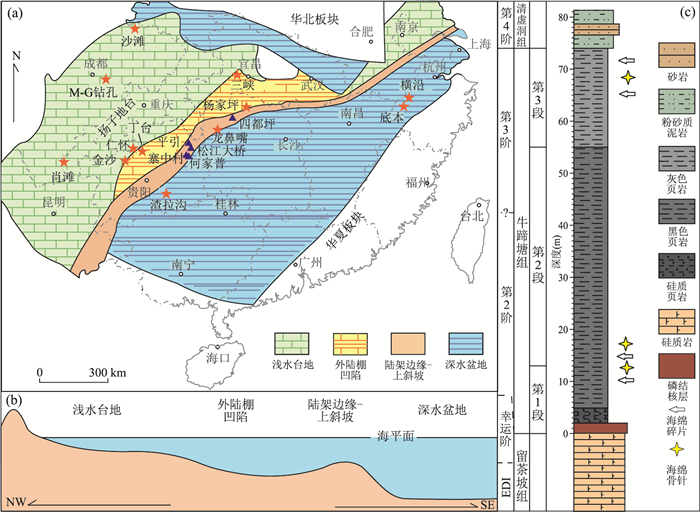
 下载:
下载:
